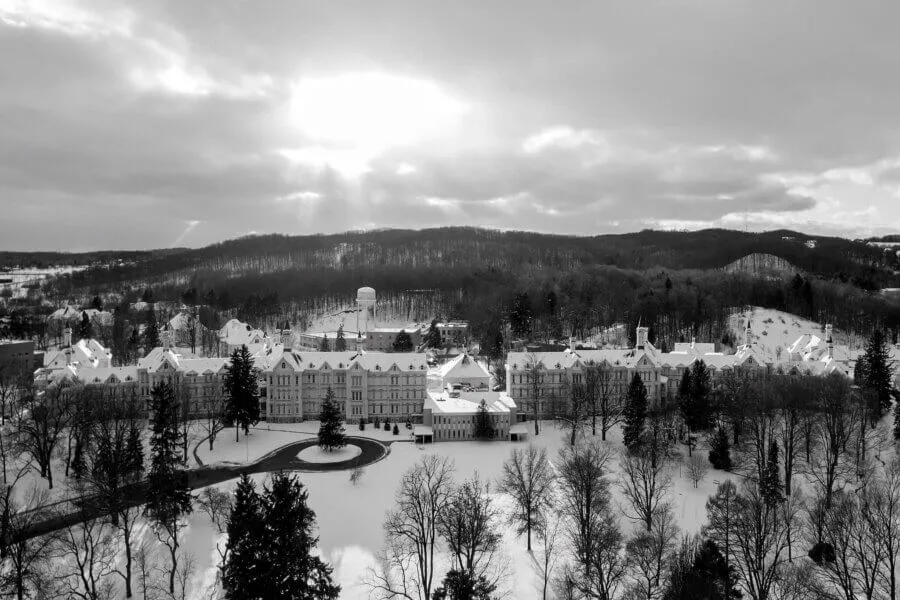
(Snlaverty via Wikimedia Commons)
Shopping, history, good food, spooky stories—and so much more. These are nine things that every visitor (and local) should know about the Village at Grand Traverse Commons in Traverse City.
MICHIGAN—Once a psychiatric hospital, now an upscale shopping and dining experience, the old Northern Michigan Asylum grounds are an unforgettable stop on any Up North road trip.
If the name doesn’t ring a bell, that may be because the place has been known by many of them over the last century or so: Northern Michigan Asylum, Traverse City Regional Psychiatric Hospital, Traverse City State Hospital, Northern Michigan State Hospital, and today, the Village at Grand Traverse Commons. And like the list of names, the campus has a history that runs pretty deep.
From 1885 through 1989, the Northern Michigan Asylum treated about 50,000 patients of all ages—initially just for those with cognitive impairments, and later to also help those with other conditions like menopause, epilepsy, autism, substance abuse, and so-called “hysteria.”
Some of that history is pretty dark. In the early days of the hospital, mental health treatment was a disaster—and some of the treatment was so inhumane that it bordered on torture. Stories of forced commitments and slipshod conditions for patients are common, and they likely serve as the impetus for stories of so-called “hauntings” that have scared visitors there for decades.
Regardless of whether those ghost stories are true, there are few sites in Michigan that carry as much history as the old Northern Michigan Asylum.
Here are nine things to know:
1. The hospital thrived largely because the lumber industry died.
For about 30 years before the Northern Michigan Asylum opened in 1885, Traverse City was known almost exclusively as a lumber town—one of many in Michigan to take advantage of abundant white pine in the state in the 1800s. Perry Hannah, a lumber baron now considered the “Father of Traverse City,” bought a sawmill there in 1851, and the rest of the city followed.
And if not for that sawmill, the hospital buildings likely would not exist today.
In the late 1800s, Michigan had only two psychiatric hospitals: one in Kalamazoo, and another in Pontiac. Hannah, who reportedly long predicted the decline of the local lumber industry, was among the leading proponents of opening a third hospital in Traverse City. He wanted to do anything to keep the local economy afloat, and he viewed the hospital as a convenient life raft.
And history shows that Hannah was spot on. Michigan’s lumber industry dried up near the turn of the century and Traverse City State Hospital went on to become the city’s largest employer.
2. There’s a reason for the cream-colored bricks.
The distinct bricks that line the Village at Grand Traverse Commons weren’t so much an aesthetic choice—they were among the only local bricks that were available at the time.
Between 1874 and 1907, James Markham produced the bricks at a company along the shores of nearby Cedar Lake. And for a time, it was the largest brick factory in northern Michigan.
All told, more than 8 million “Markham Bricks” were used to build the hospital—a remarkable feat considering only hand tools and mule power were used to put it all together.
Markham bricks were also used to build two homes for the two master masons who were hired to build the asylum. They still stand today on the corner of Division and W. Seventh Street.
3. These are Michigan’s last “Kirkbride” buildings.
 Pennsylvania psychiatrist Thomas Kirkbride revolutionized mental hospitals with his trademark design—and the Grand Traverse Commons is the last remnant of his iconic style in Michigan.
Pennsylvania psychiatrist Thomas Kirkbride revolutionized mental hospitals with his trademark design—and the Grand Traverse Commons is the last remnant of his iconic style in Michigan. Kirkbride emphasized privacy and comfort for patients, and his designs always came with expansive landscaping plans to incorporate sunlight and fresh air as therapy. Between 1845 and 1910, a total of 73 Kirkbride hospitals were constructed. Only about half of them still exist today.
Kirkbride buildings are reportedly the inspiration for Arkham Asylum, the fictional psychiatric hospital in the Batman series that houses villains like the Joker. Another Kirkbride building in Oregon was the primary filming location for the 1975 film One Flew Over the Cuckoo’s Nest.
4. The hospital didn’t use straitjackets.
Both Kirkbride and the hospital’s first superintendent, Dr. James Decker Munson, believed in the “Beauty is Therapy” and “Work is Therapy” treatment models. And that meant no restraints. Instead, patients could freely roam the grounds, use the hiking trails, and enjoy the beautiful aesthetics of the manicured grounds, interior design, and architecture as a form of treatment.
5. It’s one of the largest redevelopment projects in the western hemisphere.
Detroit area transplant Ray Minervini is the brains behind the idea to redevelop the old asylum. Businesses began to open in the early 2000s—and the full project was initially expected to be finished over the course of 10 to 15 years. Various setbacks (like a global pandemic) have stalled that progress. Some of the redevelopment work remains ongoing.
Minervini is said to have been inspired to preserve the site after the demolition of many other historic buildings in Detroit—and he has since reportedly invested much of his life savings into the project.
6. It’s a foodie destination.
In a way, the “beauty is therapy” model still rings true at the old asylum—just as long as you consider delicious, Instagrammable meals to be a form of therapy. The award-winning restaurants there serve a diverse array of cuisine, often made with locally-sourced ingredients.
Trattoria Stella was one of the first restaurants to arrive on the scene, turning the basement into a high-end Italian dining experience. Spanglish has traditional Mexican recipes with locally sourced ingredients and sustainable culinary practices. Sugar 2 Salt serves up communal farm-to-table brunches. Higher Grounds Trading Co. focuses on fair-trade and organic coffee that you can feel good about pouring into your cup. Earthen Ales is the on-campus brewery, and Left Foot Charley is a wine bar that works with local vineyards to produce award-winning wines.
7. There’s a year-round farmer’s market.
Freezing winters in Northern Michigan aren’t always the best time for a farmer’s market—but the Village at Grand Traverse Commons has solved the issue by serving as the toasty warm, indoor home to Traverse City’s weekly farmers markets on Saturday mornings from November through April. The market heads back outdoors on Monday afternoons between May and October.
8. Some say it’s haunted.
After the hospital shut down in 1989, the campus sat abandoned for longer than a decade. During that time, urban explorers did a lot of trespassing—and many of them got spooked. Eventually, the campus garnered a reputation as one of the most haunted places in Michigan.
Visitors have long reported an eerie sensation in some of the less developed portions of the campus, as well as the trail system that surrounds the campus. Some have claimed to have seen apparitions in hallways, and ghosts of long-departed patients looking down from windows.
Over the years, psychics have even claimed to communicate with patients who had died there. And when Trattoria Stella first opened, early employees reportedly saw ghostly activity inside.
Of course, there’s no definitive proof of any paranormal activity at the Village at Grand Traverse Commons. And as the renovations have continued to transform some of the spookier old buildings into higher-end tourist destinations, the alleged ghost sightings seem to have waned.
9. There may be a portal to hell on the grounds.
 In the forest surrounding the Grand Traverse Commons, there is a dead tree. Old wives’ tales say if you walk around this tree in a specific pattern, you’ll discover a hidden, haunted portal to hell.
In the forest surrounding the Grand Traverse Commons, there is a dead tree. Old wives’ tales say if you walk around this tree in a specific pattern, you’ll discover a hidden, haunted portal to hell.Seriously. We’re not making this stuff up.
The “Hippie Tree,” as it is known locally, is tucked in the woods behind the hospital campus. Visitors will probably have to ask a local resident for directions in order to find it quickly—but they’ll know it when they see it. It’s huge, and its branches are painted in psychedelic colors.
Some say the tree got its name from the so-called hippies that used the tree as a meet-up spot. There’s no clear consensus on how it got started, but for whatever reason, locals have also long believed that there’s some type of supernatural, otherworldly power associated with the site.
One story—possibly cooked up by the hippies said to have hung out beneath the tree—dictates that walking in a certain direction around the area can activate a so-called “portal to hell.” Other, less ominous wives’ tales say that a visit can bring good luck.
‘Gander Editor Kyle Kaminski contributed to this story.

VIDEO: Trump isn’t the only republican facing charges for alleged financial crimes
https://www.tiktok.com/@gandernewsroom/video/7361494909938978090 A whole lot of Michigan Republicans and lobbyists are facing criminal charges for...

VIDEO: It’s expensive to be poor in Michigan
https://www.tiktok.com/@gandernewsroom/video/7361154790300060974 Ever heard of predatory payday loans? Here’s how new laws could help protect...

Here’s everything you need to know about this month’s Mercury retrograde
Does everything in your life feel a little more chaotic than usual? Or do you feel like misunderstandings are cropping up more frequently than they...

The ’Gander wins multiple 2023 Michigan Press Association awards
MICHIGAN—The ’Gander Newsroom has earned multiple awards in the 2023 Michigan Press Association Better Newspaper Contest. The awards were announced...

Michigan Republicans ask Supreme Court to restrict medication abortion access
A lawsuit supported by Republicans could disrupt access to the most common form of abortion—even in Michigan, where reproductive rights are...






